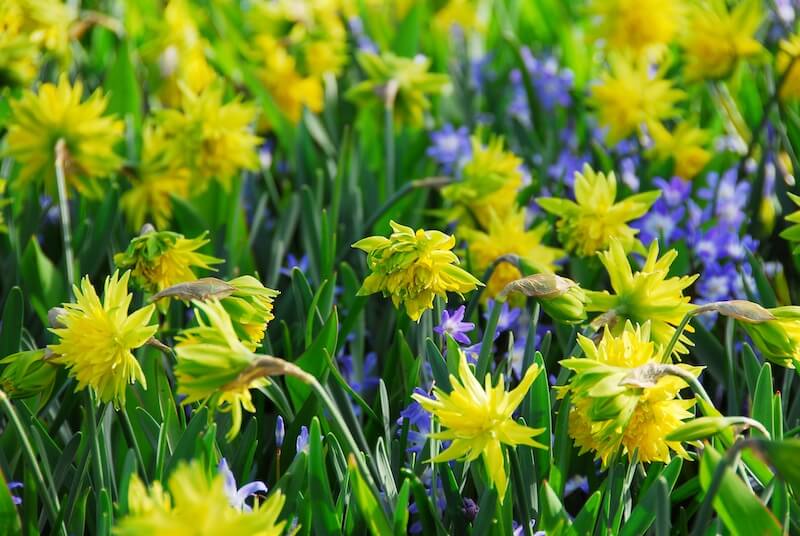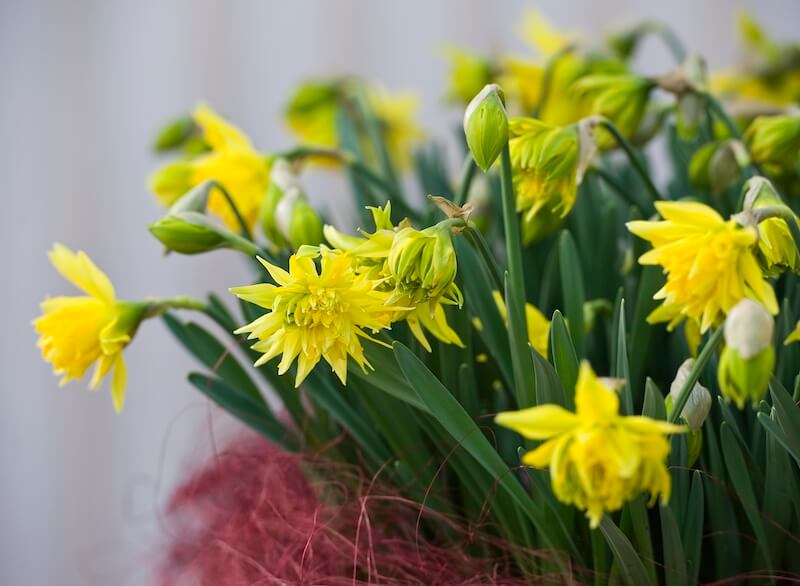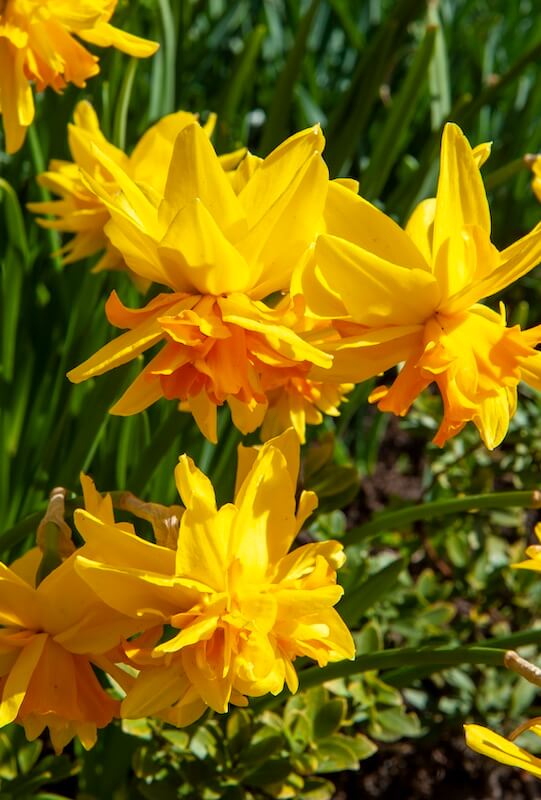
Position
- Full sun to light shade; best flowering in a sunny spot
- Prefers a sheltered site away from cold, drying winds
- Equally effective in borders, gravel beds or large containers
Hardiness
- Tolerates winter lows down to around –20 °C (–4 °F)
- A light mulch over the bulb row in late autumn helps in very exposed sites
Soil
- Thrives in fertile, well-drained soils such as loam or sandy loam
- Incorporate plenty of garden compost or well-rotted manure for improvement at planting
- Avoid heavy, waterlogged clay, which can cause bulb rot
- Adapts to acid, neutral or alkaline soils
- Performs best where organic matter maintains good structure and moisture without waterlogging
- Grab a soil test kit and ensure the perfect conditions for growth
Height
- Forms clumps that reach 15–20 cm (6–8 in) tall each spring
Seasons of Interest
Additional Notes
- Plant bulbs in autumn, about 10 cm deep and 5–7 cm apart, in groups for best impact
- Leave foliage until entirely yellow before removing to allow bulbs to replenish for next season
- Divide and replant congested clumps every 3–4 years once the leaves have died down
- Dead-head spent flowers to keep the display tidy and direct energy back into the bulb
- Suitable for naturalising in grass—lift and replace turf after flowering to avoid damage
- All parts are mildly toxic; handle bulbs with gloves and keep away from pets and children
Narcissus Rip van Winkle - An Extraordinary Dwarf Double Daffodil
Few spring bulbs are as unusual and eye-catching as Narcissus Rip van Winkle. This extraordinary dwarf daffodil produces fluffy, multi-petalled golden-yellow flowers that look almost like miniature fireworks in bloom. Compact yet bold, it makes an excellent choice for borders, pots, and rockeries.
If you want a cheerful, reliable spring flower that naturalises well and brightens your garden for years to come, Narcissus Rip van Winkle is a brilliant choice.
What makes Narcissus Rip van Winkle a unique daffodil?
Narcissus Rip van Winkle is no ordinary daffodil. This cultivar produces extraordinary, fluffy blooms that stand out among traditional trumpet daffodils. Each flower is made up of many narrow petals, giving a multi-petalled look that is both compact and striking.
The bright yellow flowers appear in early spring and last well, adding unusual texture to beds and borders. This dwarf daffodil grows to a height of just 10cm to 20cm, making it perfect for the front of the border or small rockeries.
Unlike other varieties, Narcissus Rip van Winkle delivers a quirky charm with its fluffy blooms. Each plant looks like a burst of golden fireworks, providing a real talking point in the spring garden.
What are the key features of Narcissus Rip van Winkle?
One of the key features of Narcissus Rip van Winkle is its extraordinary dwarf daffodil size. At just 15cm to 20cm tall, it remains compact, which makes it perfect for smaller spaces.
Each stem produces fluffy blooms of golden-yellow, made up of narrow petals that twist and curl, creating an almost ruffle-like effect. These bright yellow flowers are long-lasting and provide both colour and texture to spring displays.
Another key feature is its ability to naturalise well. Once planted, bulbs settle in quickly and return each next spring with vigour. With minimal maintenance, they provide joy for years to come.

When and how should you plant the bulbs?
The best time to plant bulbs of Narcissus Rip van Winkle is autumn. Planting bulbs in this season allows them to establish roots before winter sets in. By the following year, you’ll enjoy bright yellow flowers in your spring garden.
Plant the bulbs about 8-10cm deep in well-drained soil. Space them twice their width apart, or about 15cm, for strong growth. Always plant bulbs with the pointed bud facing upwards to ensure they grow correctly.
For a natural look, plant in groups rather than neat rows. Plant bulbs generously in drifts at the front of the border, in beds, or even in rockeries for cheerful splashes of colour.

What type of soil and conditions suit Narcissus Rip van Winkle?
This dwarf daffodil thrives best in well-drained soil. Drainage is essential, as waterlogged conditions can cause bulbs to rot. If your soil is heavy clay, mix in compost or grit to improve aeration and drainage.
Planting in a sunny or partially sunny spot brings the best results. Full sun encourages strong blooms, while partial shade is tolerated but may reduce flowering slightly. A bright, open position ensures the most vibrant yellow flowers.
During the growing season, soil should be kept moist but never waterlogged. Good soil preparation at planting time ensures healthy roots and better flowering in years to come.
How do you grow Narcissus Rip van Winkle in pots and containers?
Narcissus Rip van Winkle is perfect for pots and patio containers. Its compact size makes it a brilliant choice for smaller spaces, and container planting allows you to enjoy the flowers up close.
Choose a high-quality compost with good drainage. Plant bulbs at a depth of 8-10cm, keeping them twice their width apart for best results. A pot or container with drainage holes is essential to prevent waterlogging.
Keep the compost moist during growth, especially as buds emerge in spring. After flowering, allow the foliage to die back naturally before removing it. This ensures bulbs recharge for the following year.
How does Narcissus Rip van Winkle look in borders and rockeries?
In front of the border, this daffodil shines. Its bright yellow flowers bring cheerful colour at a time when the garden is just waking up—plant in groups to create a carpet-like effect that draws the eye.
Rockeries are another excellent spot for this compact plant. Its small size and fluffy blooms fit beautifully among stones and other low-growing plants. The golden-yellow colour contrasts well with greens and blues, creating a vibrant display.
Because it is a dwarf daffodil, it won’t overshadow neighbouring plants. Instead, it complements them, adding structure and variety to the spring garden.
Why do gardeners love Narcissus Rip van Winkle as a cut flower?
Though small, Narcissus Rip van Winkle makes a charming cut flower. Its multi-petalled, fluffy blooms add texture and colour to spring arrangements.
The stem is sturdy enough to hold the weight of the flower, and the blooms last well indoors. Their bright yellow colour adds freshness to vases and table displays.
When used as a cut flower, combine with tulips or muscari for striking seasonal arrangements. Always remember, like all narcissus bulbs, the plant is harmful if eaten, so keep arrangements out of reach of pets.
How should you care for Narcissus Rip van Winkle after flowering?
After flowering, let the foliage die back naturally. Cutting it too soon weakens the bulb, reducing blooms the following year. Leaves should be left until they yellow, allowing energy to return to the bulb.
Deadhead spent flowers to stop seed production and focus energy back into the bulb. This helps plants establish better for the following year.
With the proper care, Narcissus Rip van Winkle remains a reliable perennial. Allowing foliage to die back naturally before removal is the simplest way to ensure a strong display next spring.
What height and spread should you expect from this dwarf daffodil?
Narcissus Rip van Winkle is a compact, dwarf daffodil. It typically reaches a height of 15cm to 20cm, making it one of the smallest daffodils in UK gardens.
Despite its small size, each flower is bold. The bright yellow flowers, made up of many narrow petals, provide extraordinary colour. The compact growth makes it perfect for small beds, pots, and rockeries.
Bulbs naturalise well, so over time, clumps expand and fill larger areas. This creates more vibrant displays, ensuring colour spreads further with each passing year.
Why is Narcissus Rip van Winkle an excellent choice for UK gardeners?
For the UK gardener, Narcissus Rip van Winkle ticks all the boxes. It is easy to grow, low-maintenance, and offers extraordinary colour each spring.
This miniature daffodil is tough enough to handle UK weather, and once planted, it naturalises easily, ensuring cheerful blooms for years to come. Its distinctive, fluffy flowers make it a standout feature in any spring garden.
Whether grown in pots, borders, or rockeries, Narcissus Rip van Winkle adds texture and vibrancy. For gardeners seeking something different from traditional trumpet daffodils, this double daffodil is a brilliant choice.
From Darren’s Patch
Narcissus Rip van Winkle never fails to raise a smile in my garden. Those fluffy, golden blooms may be small in stature, but they pack a surprising punch, brightening the front of borders and pots when little else is awake. I find they work best planted in generous clusters, where the quirky flowers create a cheerful splash of early spring colour. Over the years, mine have naturalised into tight clumps that return reliably each season, with no fuss at all. That easy-going nature is precisely why I rate them so highly – they offer character, charm, and consistency without demanding much in return. For me, they’re proof that sometimes the smallest plants bring the most immense joy.
![]()
Key Points to Remember
- An extraordinary dwarf daffodil with fluffy, golden-yellow double flowers
- Grows to a compact height of 15cm to 20cm
- Plant bulbs in autumn at a depth of 8-10cm
- Space bulbs twice their width apart for best results
- Thrives in sunny or partially sunny spots with well-drained soil
- Perfect for pots, containers, rockeries, and the front of the border
- Deadhead flowers and allow foliage to die back naturally before removing
- Works well as a cut flower, with long-lasting, bright yellow blooms
- Naturalises well and provides colour in gardens for years to come
- Like all narcissus bulbs, they are harmful if eaten, so handle with care
Narcissus Rip van Winkle is a charming early spring bulb that naturalises into tight clumps of 15–20 cm (6–8 in) stems bearing soft yellow blooms from February to March. With full sun, well-drained, improved soil and simple autumn planting, it makes a low-maintenance and delightful spring feature in UK gardens.
Want to learn about other bulb varieties? Read about Narcissus Tahiti here.
For more information on Spring Flowering Bulbs for your garden, please click here.

Frequently Asked Questions
Q: What is Narcissus Rip van Winkle?
A: Narcissus Rip van Winkle is an extraordinary dwarf daffodil prized for its multi-petalled, fluffy blooms. This miniature daffodil produces greenish-yellow flowers with a soft, layered centre that stands apart from single-trumpet types. As a compact, reliable perennial, it naturalises well in lawns, rockeries and borders, offering bright, early spring colour. Gardeners value this narcissus for its neat habit and dependable performance. Planting a group of these bulbs gives more impact than single specimens, and their modest height makes them ideal for the front of the border or patio containers where small, vivid displays are needed.
Q: What are the key features of Daffodil Rip van Winkle?
A: Key features include compact growth, multi-petalled heads and an unusually soft, almost fluffy bloom form. This narcissus typically reaches a modest height, making it suitable for rockeries, pots and front-of-border planting. The distinctive greenish yellow flowers offer subtle colour where brilliant yellow might be too bold. Each bulb often produces a healthy stem and neat foliage, and the cultivar establishes quickly once planted. Rip van Winkle is easy to grow, tolerates a range of soils if well-drained, and provides seasons of interest as the clumps naturalise and increase in years to come.
Q: When and how should I plant these daffodil bulbs?
A: Plant narcissus bulbs in autumn, ideally before the soil cools. Choose high-quality, healthy bulbs and plant to a depth of around 8–10cm for smaller varieties, or 10–15cm for larger ones. Space bulbs twice their width apart to allow room to establish. In groups or drifts, Rip Van Winkle will create a more natural effect than single rows. Planting in early autumn helps roots develop before winter. Firm the soil over bulbs and water in if conditions are dry. With correct autumn planting, these spring bulbs will establish well for seasons ahead.
Q: What soil and light conditions does Narcissus Rip van Winkle prefer?
A: This daffodil thrives in well-drained soil and a sunny or lightly shaded site. Good drainage prevents bulb rot and encourages healthy bloom. If the soil is heavy, improve it with compost or grit to create a friable texture. Keep the soil moist during the growing season, but avoid waterlogging. A sunny spot brings stronger stems and brighter flowers, though Rip Van Winkle will tolerate partial shade. These conditions help bulbs establish and naturalise well, producing reliable flowering and foliage that dies back naturally before removing in late spring.
Q: Can I grow Rip van Winkle in pots or containers?
A: Yes, Rip van Winkle performs well in containers and small pots, making it perfect for patios and entrances. Choose a pot at least 15–20cm deep and use a free-draining compost. Plant bulbs so the top of each bulb sits at the recommended depth—about 8–10cm for most miniature narcissus—then cover and water. Group bulbs closely for a fuller display and position the container in a sunny spot for best results. Remember to keep compost moist during the growing season and allow foliage to die back naturally after flowering.
Q: How should I care for these double daffodil bulbs after flowering?
A: After bloom, deadhead spent flowers to prevent seed set and direct energy back into the bulb. Allow foliage to die back naturally before removing; the leaves feed the bulb for next spring’s bloom. Feed lightly in spring as new growth appears to help replenish reserves. If clumps become crowded over time, lift and divide bulbs once the foliage has yellowed, then replant immediately or store in a cool, dry place until autumn. Proper aftercare ensures strong, consistent flowering from these daffodil bulbs for years to come.
Q: How tall do Narcissus Rip van Winkle plants typically grow?
A: Rip van Winkle is a compact daffodil that usually stays modest in stature, often around 15–20cm in height, depending on growing conditions. This smaller height makes it an excellent miniature daffodil for the very front of a border or in rockeries where low scale matters. Despite its size, the flowerheads are characterful and can appear surprisingly full thanks to their multi-petalled form. The low growth habit reduces wind damage and helps the blooms remain tidy and attractive through the early spring season.
Q: Where can I purchase Narcissus Rip van Winkle bulbs?
A: Narcissus Rip van Winkle bulbs are widely available in the UK from garden centres and reputable online suppliers. Buying from trusted sources helps ensure you receive high-quality, disease-free bulbs that are ready for autumn planting. Many nurseries stock these bulbs as part of their spring-flowering bulbs range, and purchasing in autumn gives the best selection. Whether you prefer to buy in person or online, choose good-sized bulbs and follow planting guidance to ensure reliable blooms in the following spring.
